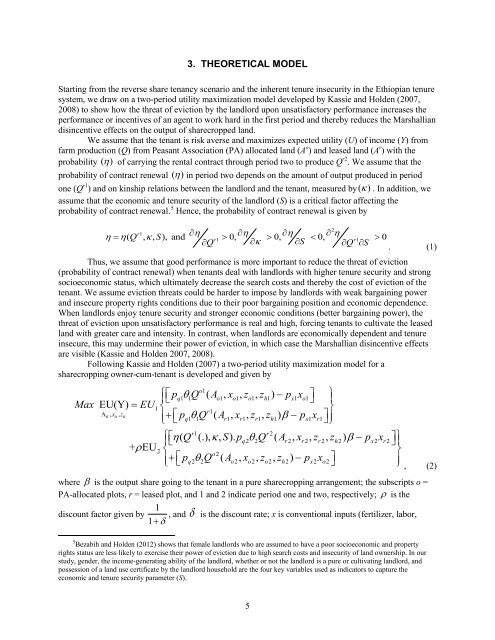Reverse-Share-Tenancy and Marshallian Inefficiency - International ...
Reverse-Share-Tenancy and Marshallian Inefficiency - International ...
Reverse-Share-Tenancy and Marshallian Inefficiency - International ...
Create successful ePaper yourself
Turn your PDF publications into a flip-book with our unique Google optimized e-Paper software.
3. THEORETICAL MODEL<br />
Starting from the reverse share tenancy scenario <strong>and</strong> the inherent tenure insecurity in the Ethiopian tenure<br />
system, we draw on a two-period utility maximization model developed by Kassie <strong>and</strong> Holden (2007,<br />
2008) to show how the threat of eviction by the l<strong>and</strong>lord upon unsatisfactory performance increases the<br />
performance or incentives of an agent to work hard in the first period <strong>and</strong> thereby reduces the <strong>Marshallian</strong><br />
disincentive effects on the output of sharecropped l<strong>and</strong>.<br />
We assume that the tenant is risk averse <strong>and</strong> maximizes expected utility (U) of income (Y) from<br />
farm production (Q) from Peasant Association (PA) allocated l<strong>and</strong> (A o ) <strong>and</strong> leased l<strong>and</strong> (A r ) with the<br />
probability ( η)<br />
of carrying the rental contract through period two to produce Q r2 . We assume that the<br />
probability of contract renewal ( η)<br />
in period two depends on the amount of output produced in period<br />
one (Q r1 ) <strong>and</strong> on kinship relations between the l<strong>and</strong>lord <strong>and</strong> the tenant, measured by ( κ)<br />
. In addition, we<br />
assume that the economic <strong>and</strong> tenure security of the l<strong>and</strong>lord (S) is a critical factor affecting the<br />
probability of contract renewal. 5 Hence, the probability of contract renewal is given by<br />
2<br />
r1<br />
η = η( Q , κ, S), <strong>and</strong><br />
∂η r1 > 0,<br />
∂η > 0,<br />
∂η < 0,<br />
∂ η<br />
r1<br />
> 0<br />
∂Q ∂κ<br />
∂S<br />
∂Q ∂S<br />
. (1)<br />
Thus, we assume that good performance is more important to reduce the threat of eviction<br />
(probability of contract renewal) when tenants deal with l<strong>and</strong>lords with higher tenure security <strong>and</strong> strong<br />
socioeconomic status, which ultimately decrease the search costs <strong>and</strong> thereby the cost of eviction of the<br />
tenant. We assume eviction threats could be harder to impose by l<strong>and</strong>lords with weak bargaining power<br />
<strong>and</strong> insecure property rights conditions due to their poor bargaining position <strong>and</strong> economic dependence.<br />
When l<strong>and</strong>lords enjoy tenure security <strong>and</strong> stronger economic conditions (better bargaining power), the<br />
threat of eviction upon unsatisfactory performance is real <strong>and</strong> high, forcing tenants to cultivate the leased<br />
l<strong>and</strong> with greater care <strong>and</strong> intensity. In contrast, when l<strong>and</strong>lords are economically dependent <strong>and</strong> tenure<br />
insecure, this may undermine their power of eviction, in which case the <strong>Marshallian</strong> disincentive effects<br />
are visible (Kassie <strong>and</strong> Holden 2007, 2008).<br />
Following Kassie <strong>and</strong> Holden (2007) a two-period utility maximization model for a<br />
sharecropping owner-cum-tenant is developed <strong>and</strong> given by<br />
o1<br />
⎧ pq 1θ<br />
1Q ( Ao 1, xo 1, zo 1, zh 1)<br />
px 1x<br />
⎫<br />
⎪⎣<br />
⎡<br />
−<br />
o1⎦ ⎤<br />
⎪<br />
Max EU(Y) = EU1<br />
⎨ ⎬<br />
A<br />
1<br />
it , xit<br />
, z<br />
r<br />
it<br />
⎪ ⎡pq 1θ1Q ( Ar1, xr1, zr1, zh 1)<br />
β px 1x<br />
⎤<br />
⎩<br />
+ ⎣<br />
−<br />
r1⎦⎪⎭<br />
⎧<br />
⎪<br />
⎡<br />
⎣η( Q (.), κ, S). p θ Q ( A , x , z , z ) β − p x<br />
+ ρEU2<br />
⎨<br />
o2<br />
⎪+ ⎡pq2θ<br />
2Q ( Ao2,<br />
xo2, zo2, zh2)<br />
px2x<br />
⎤<br />
⎩ ⎣<br />
−<br />
o2⎦<br />
r1 r2<br />
q2 2 r2 r2 r2 h2 x2 r2<br />
, (2)<br />
where β is the output share going to the tenant in a pure sharecropping arrangement; the subscripts o =<br />
PA-allocated plots, r = leased plot, <strong>and</strong> 1 <strong>and</strong> 2 indicate period one <strong>and</strong> two, respectively; ρ is the<br />
1<br />
discount factor given by , <strong>and</strong> δ is the discount rate; x is conventional inputs (fertilizer, labor,<br />
1+<br />
δ<br />
⎤⎫<br />
⎦⎪<br />
⎬<br />
⎪⎭<br />
5 Bezabih <strong>and</strong> Holden (2012) shows that female l<strong>and</strong>lords who are assumed to have a poor socioeconomic <strong>and</strong> property<br />
rights status are less likely to exercise their power of eviction due to high search costs <strong>and</strong> insecurity of l<strong>and</strong> ownership. In our<br />
study, gender, the income-generating ability of the l<strong>and</strong>lord, whether or not the l<strong>and</strong>lord is a pure or cultivating l<strong>and</strong>lord, <strong>and</strong><br />
possession of a l<strong>and</strong> use certificate by the l<strong>and</strong>lord household are the four key variables used as indicators to capture the<br />
economic <strong>and</strong> tenure security parameter (S).<br />
5
















